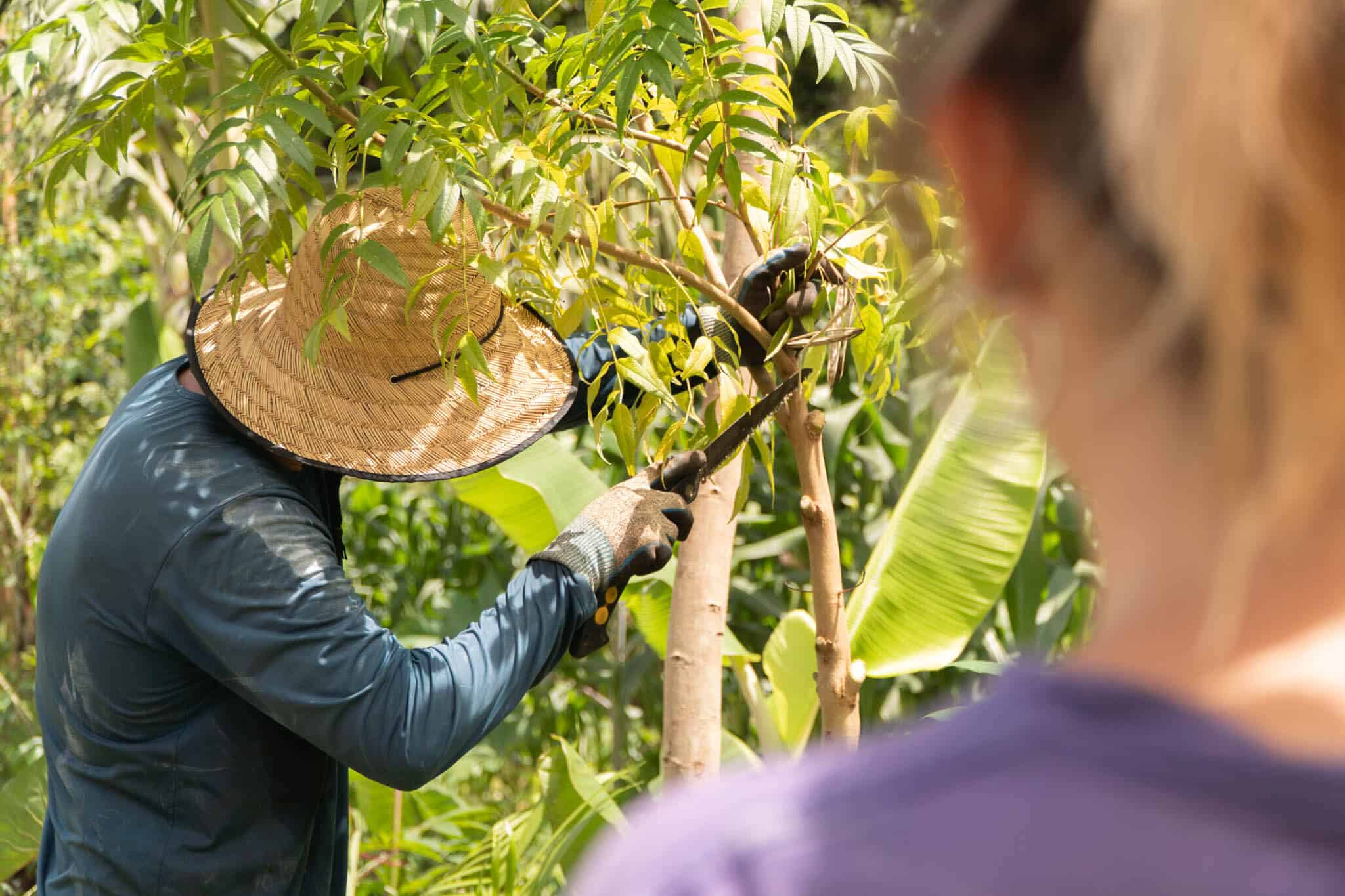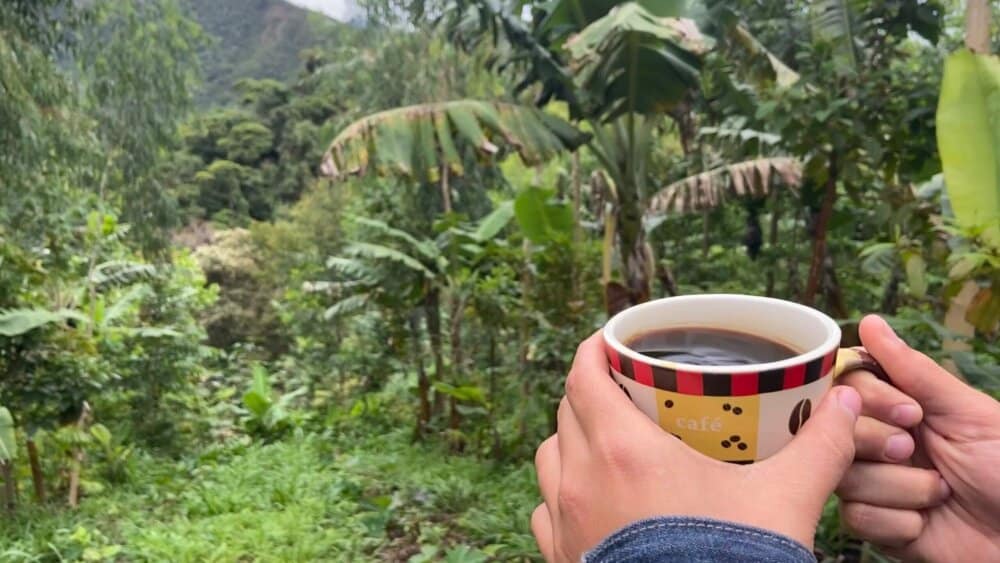[vc_row css=”.vc_custom_1739379399395{margin-right: 30px !important;margin-left: 30px !important;}”][vc_column][swmsc_text_block id=”” class=”” style=””]Eucalyptus trees have long been debated in agroforestry, often criticized for their high water consumption and alleged negative effects on biodiversity. However, in syntropic agroforestry, a regenerative farming approach pioneered by Ernst Götsch, eucalyptus plays a crucial role in accelerating ecosystem recovery, enhancing soil fertility, and providing essential biomass. When managed correctly, eucalyptus is not harmful—it actively contributes to the creation of thriving, biodiverse agroforestry systems.[/swmsc_text_block][gap size=”30px” id=”” class=”” style=””][/vc_column][/vc_row][vc_row css=”.vc_custom_1740408802641{margin-right: 30px !important;margin-left: 30px !important;}”][vc_column width=”1/2″][swmsc_text_block id=”” class=”” style=””]
Understanding
Syntropic Agroforestry
Syntropic agroforestry is an innovative farming system that mimics natural forest succession to establish self-sustaining, productive ecosystems. By combining different plant species at various growth stages, it improves soil health, enhances biodiversity, and increases water retention. Götsch’s principles emphasize biomass production, nutrient cycling, and ecological succession—all of which align perfectly with eucalyptus use in agroforestry.
[/swmsc_text_block][gap size=”30px” id=”” class=”” style=””][/vc_column][vc_column width=”1/2″][gap size=”30px” id=”” class=”” style=””][vc_single_image image=”27034″ img_size=”large” css=””][/vc_column][/vc_row][vc_row css=”.vc_custom_1739379399395{margin-right: 30px !important;margin-left: 30px !important;}”][vc_column][gap size=”30px” id=”” class=”” style=””][swmsc_text_block id=”” class=”” style=””]
Why Eucalyptus Is Essential in Syntropic Agroforestry
In a well-managed agroforestry system, eucalyptus provides multiple benefits that contribute to soil regeneration and ecosystem resilience.[/swmsc_text_block][/vc_column][/vc_row][vc_row css=”.vc_custom_1740408854358{margin-right: 30px !important;margin-left: 30px !important;}”][vc_column width=”1/2″ css=”.vc_custom_1740579636539{margin-right: 100px !important;padding-right: 50px !important;}”][gap size=”30px” id=”” class=”” style=””][gap size=”30px” id=”” class=”” style=””][swmsc_image link=”#” lightbox=”true” target=”_self” lightbox_type=”image” align=”left” alt=”” title=”” border_radius=”0px” id=”” class=”” style=”” src=”27101″][/vc_column][vc_column width=”1/2″][gap size=”30px” id=”” class=”” style=””][swmsc_text_block id=”” class=”” style=””]
-
Rapid Biomass Production
Eucalyptus is one of the fastest-growing trees used in agroforestry. Its rapid growth allows for frequent pruning (2 to 4 times per year), generating large amounts of organic material that enriches the soil with mulch and enhances microbial life. This continuous biomass input improves soil fertility and supports the growth of fruit trees, native species, and crops.
-
Nutrient Pumping and Soil Enrichment
Eucalyptus has a deep root system that extracts nutrients from subsoil layers—nutrients that many plants cannot access. These nutrients are then returned to the surface through leaf litter, pruned branches, and root exudates, effectively recycling minerals and enriching the topsoil for other trees and crops.[/swmsc_text_block][/vc_column][/vc_row][vc_row css=”.vc_custom_1740408874000{margin-right: 30px !important;margin-left: 30px !important;}”][vc_column][gap size=”30px” id=”” class=”” style=””][swmsc_text_block id=”” class=”” style=””]
-
Microclimate Regulation
Eucalyptus trees help regulate temperature and moisture levels by providing shade and wind protection. This creates a favorable environment for sensitive understory plants, allowing native and fruit-bearing species to thrive, reducing water evaporation, and helping the overall system retain moisture.
-
Soil Structure, Water Retention, and Mycorrhizal Fungi Stimulation
Despite concerns about eucalyptus being a water-intensive species, it contributes to long-term soil hydration in syntropic systems. The continuous addition of organic matter through pruning improves soil structure and water retention capacity, helping to combat erosion and restore degraded land.
Additionally, eucalyptus biomass plays a crucial role in stimulating mycorrhizal fungi activity in the soil. Mycorrhizae are beneficial fungi that form symbiotic relationships with plant roots, enhancing their ability to absorb water and nutrients. The decomposition of eucalyptus leaves and branches creates a rich organic layer that promotes fungal networks, improving nutrient exchange and soil biodiversity. This is particularly beneficial for climax trees and food-producing species, ensuring better root development and overall ecosystem resilience.[/swmsc_text_block][/vc_column][/vc_row][vc_row css=”.vc_custom_1740408960652{margin-right: 30px !important;margin-left: 30px !important;}”][vc_column width=”1/2″][swmsc_text_block id=”” class=”” style=””]
-
Eucalyptus as a Managed Successional Tree
Eucalyptus is not a permanent species in syntropic agroforestry but serves as a pioneer tree to facilitate the development of a more complex ecosystem. At Eco Caminhos, our system follows this structured approach:
- Pruned 2 to 4 times per year to generate organic matter.
- Cut entirely every 4 years to stimulate regrowth.
- This cycle is repeated up to 3 times (approximately 12 years).
- After 12 years, the eucalyptus does not grow back, allowing native climax trees to take over without requiring eucalyptus removal.
By the time eucalyptus stops regenerating, native climax trees, fruit trees, and other long-term species have already established themselves, ensuring ecosystem stability and productivity.
Watch how pruning is done in this video![/swmsc_text_block][/vc_column][vc_column width=”1/2″][vc_single_image image=”27096″ img_size=”large” css=””][/vc_column][/vc_row][vc_row css=”.vc_custom_1740408920006{margin-right: 30px !important;margin-left: 30px !important;}”][vc_column][gap size=”30px” id=”” class=”” style=””][swmsc_text_block id=”” class=”” style=””]
Addressing Common Concerns
Water Usage
Eucalyptus trees do consume significant water, but in diverse agroforestry systems, this is counterbalanced by their role in soil regeneration. Their biomass input improves soil moisture retention and enhances rainwater infiltration.
Allelopathy and Soil Depletion
Eucalyptus is often criticized for its allelopathic effects, but these concerns primarily stem from large-scale monoculture plantations. In a high-diversity agroforestry system, continuous pruning, organic matter cycling, and the presence of other plant species prevent negative allelopathic effects, ensuring a balanced and nutrient-rich soil.[/swmsc_text_block][/vc_column][/vc_row][vc_row css=”.vc_custom_1731520578623{margin-right: 20px !important;margin-left: 20px !important;}”][vc_column width=”1/2″][gap size=”30px” id=”” class=”” style=””][swmsc_simple_section id=”” class=”” style=””][vc_single_image image=”27087″ img_size=”large” css=””][/swmsc_simple_section][/vc_column][vc_column width=”1/2″][gap size=”30px” id=”” class=”” style=””][swmsc_text_block id=”” class=”” style=””]
Eucalyptus in Eco Caminhos’ Agroforestry Project
At Eco Caminhos, eucalyptus plays a crucial role in pioneering and accelerating the succession process in our agroforestry systems. By leveraging its rapid growth, biomass production, and deep-root nutrient cycling, we improve soil health and facilitate the establishment of diverse, productive, and resilient agroforestry landscapes.
After 12 years, eucalyptus naturally phases out, making way for native and productive species that ensure long-term ecosystem balance and productivity. The result is a thriving, biodiverse agricultural model that supports both sustainable food production and ecological restoration.
[/swmsc_text_block][/vc_column][/vc_row][vc_row][vc_column][swmsc_simple_section id=”” class=”” style=””][gap size=”30px” id=”” class=”” style=””][swmsc_text_block id=”” class=”” style=””]
Conclusion
When used strategically in syntropic agroforestry, eucalyptus is a powerful tool for regenerating degraded land, increasing biomass production, and facilitating ecosystem development. By pruning regularly and managing its succession, farmers can maximize its benefits while ensuring the long-term sustainability of the system.
Furthermore, eucalyptus biomass plays a key role in enhancing mycorrhizal fungi activity, which in turn improves soil structure, root development, and nutrient exchange, creating healthier and more resilient agroforestry systems.
At Eco Caminhos, we demonstrate how eucalyptus, when properly integrated, contributes to a regenerative and profitable agroforestry model.
Interested in seeing how we implement eucalyptus and synterpic agroforestry in practice? Visit our Agroforestry Project Page to learn more or come and learn in practice through one of our programs![/swmsc_text_block][/swmsc_simple_section][/vc_column][/vc_row]




